http://en.wikipedia.org/wiki/Superposition_theorem
Superposition theorem
From Wikipedia, the free encyclopedia
This article is about the superposition theorem in electrical circuits. For other uses, see Superposition (disambiguation).
The superposition theorem for electrical circuits states that for a linear system the response (Voltage or Current) in any branch of a bilateral linear circuit having more than one independent source equals the algebraic sum of the responses caused by each independent source acting alone, while all other independent sources are replaced by their internal impedances.
To ascertain the contribution of each individual source, all of the other sources first must be "turned off" (set to zero) by:
- Replacing all other independent voltage sources with a short circuit (thereby eliminating difference of potential. i.e. V=0, internal impedance of ideal voltage source is ZERO (short circuit)).
- Replacing all other independent current sources with an open circuit (thereby eliminating current. i.e. I=0, internal impedance of ideal current source is infinite (open circuit).
This procedure is followed for each source in turn, then the resultant responses are added to determine the true operation of the circuit. The resultant circuit operation is the superposition of the various voltage and current sources.
The superposition theorem is very important in circuit analysis. It is used in converting any circuit into its Norton equivalent orThevenin equivalent.
Applicable to linear networks (time varying or time invariant) consisting of independent sources, linear dependent sources, linear passive elements Resistors, Inductors, Capacitors and linear transformers.
Another point that should be considered is that superposition only works for voltage and current but not power. In other words the sum of the powers is not the real consumed power. To calculate power we should first use superposition to find both current and voltage of that linear element and then calculate sum of the multiplied voltages and currents respectively.
http://www.tina.com/English/tina/course/12super/super
Superposition Theorem
Definition
The superposition theorem states that in a linear circuit with several sources, the current and voltage for any element in the circuit is the sum of the currents and voltages produced by each source acting independently.
To calculate the contribution of each source independently, all the other sources must be removed and replaced without affecting the final result. When removing a voltage source, its voltage must be set to zero, which is equivalent to replacing the voltage source with a short circuit. When removing a current source, its current must be set to zero, which is equivalent to replacing the current source with an open circuit.
When you sum the contributions from the sources, you should be careful to take their signs into account. It is best to assign a reference direction to each unknown quantity, if it is not already given.
The total voltage or current is calculated as the algebraic sum of the contributions from the sources. If a contribution from a source has the same direction as the reference direction, it has a positive sign in the sum; if it has the opposite direction, then a negative sign.
The total voltage or current is calculated as the algebraic sum of the contributions from the sources. If a contribution from a source has the same direction as the reference direction, it has a positive sign in the sum; if it has the opposite direction, then a negative sign.
Note that If the voltage or current sources have internal resistance, it must remain in the circuit and still be considered. In TINA, you can assign an internal resistance to the DC voltage and current sources, while using the same schematic symbol. Therefore, if you want to illustrate the superposition theorem and at the same time use sources with internal resistance, you should only set the source voltage (or current) to zero, which leaves the source internal resistance intact. Alternatively, you could replace the source with a resistor equal to its internal resistance.
In order to use the superposition theorem with circuit currents and voltages, all of the components must be linear; that is, for all resistive components, the current must be proportional to the applied voltage (satisfying Ohm’s law).
Note that the superposition theorem is not applicable to power, since power is not a linear quantity. The total power delivered to a resistive component must be determined using the total current through or the total voltage across the component and cannot be determined by a simple sum of the powers produced by the sources independently.
Let us illustrate the method of superposition by the following example.
Find the voltage across resistor R.
Follow the method step by step:
First, calculate V’, the voltage produced by the voltage source VS, using voltage division:
V’ = VS * R / (R+R1) = 10*10/(10+10) = 5 V.
V’ = VS * R / (R+R1) = 10*10/(10+10) = 5 V.
Next, find the voltage caused by the current source IS. Since it has the opposite direction,
V” = -IS * R*R1/(R+R1) = -2*10*10/(10+10) = -10 V.
V” = -IS * R*R1/(R+R1) = -2*10*10/(10+10) = -10 V.
Finally,

the unknown voltage is the sum of V’ and V”: V = V’ + V” =5 + (-10) = -5 V.
Note that the signs of the partial answers V’ and V’’ had an important role in the solution. Be careful to determine and use the correct signs.
{Solution by TINA's Interpreter}
{Using the superposition theorem}
V1:=-Is*R*R1/(R+R1);
V1=[-10]
V2:=Vs*R/(R+R1);
V2=[5]
V:=V1+V2;
V=[-5]
{Using the superposition theorem}
V1:=-Is*R*R1/(R+R1);
V1=[-10]
V2:=Vs*R/(R+R1);
V2=[5]
V:=V1+V2;
V=[-5]
Example 1
Find the currents shown by the ammeters.
The following figure shows the steps of the superposition method for the solution.

In the first step (left side of the figure above), we calculate the contributions I1’ and I2’ produced by the source V2. In the second step (right side of the figure), we calculate the contributions I1’’ and I2’’ produced by the source V1.
Finding I1’ first, we should calculate R13 (the total resistance of parallel connected R1 and R3) and then use the voltage division rule to calculate V13, the common voltage across these two resistors. Finally, to calculate I1’ (the current through R1), we should use Ohm’s law and divide V13 by R1.



With a similar consideration for all the quantities:
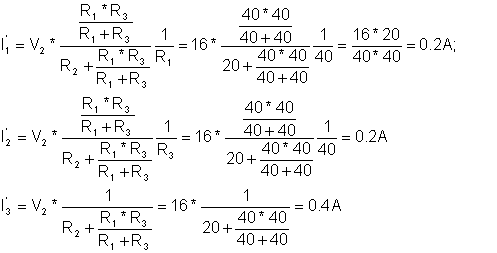
And
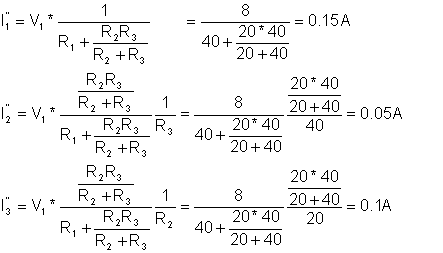
Finally, the result:

You can check the correctness of the steps using TINA as shown in the figures above.
{Solution by TINA's Interpreter}
{Use the superposition method!}
{We use doubled subscript because
the Interpreter does not allow the' and " as an index.
the second subscript means the first or second measuring}
I11:=V2*R1*R3/(R1+R3)/(R2+R1*R3/(R1+R3))/R1;
I21:=V2*R1*R3/(R1+R3)/(R2+R1*R3/(R1+R3))/R3;
I31:=-V2/(R2+R1*R3/(R1+R3));
I12:=-V1/(R1+R2*R3/(R2+R3));
I22:=V1*R2/(R2+R3)/(R1+R2*R3/(R2+R3));
I32:=V1*R3/(R2+R3)/(R1+R2*R3/(R2+R3));
I1:=I11+I12;
I1=[50m]
I2:=I21+I22;
I2=[250m]
I3:=I31+I32;
I3=[-300m]
{Use the superposition method!}
{We use doubled subscript because
the Interpreter does not allow the' and " as an index.
the second subscript means the first or second measuring}
I11:=V2*R1*R3/(R1+R3)/(R2+R1*R3/(R1+R3))/R1;
I21:=V2*R1*R3/(R1+R3)/(R2+R1*R3/(R1+R3))/R3;
I31:=-V2/(R2+R1*R3/(R1+R3));
I12:=-V1/(R1+R2*R3/(R2+R3));
I22:=V1*R2/(R2+R3)/(R1+R2*R3/(R2+R3));
I32:=V1*R3/(R2+R3)/(R1+R2*R3/(R2+R3));
I1:=I11+I12;
I1=[50m]
I2:=I21+I22;
I2=[250m]
I3:=I31+I32;
I3=[-300m]
Example 2
Find the voltage V and the current I.
The figure shows how can you use the superposition theorem:

{Solution by TINA's Interpreter!}
{Using the superposition method !}
I1:=Is*R1/(R1+R1);
I2:=-Vs/(R1+R1)
I:=I1+I2;
I=[0]
V1:=0;
V2:=Vs;
V:=V1+V2;
V=[2]
{Using the superposition method !}
I1:=Is*R1/(R1+R1);
I2:=-Vs/(R1+R1)
I:=I1+I2;
I=[0]
V1:=0;
V2:=Vs;
V:=V1+V2;
V=[2]
Example 3
Find the voltage V.
And the superposition:
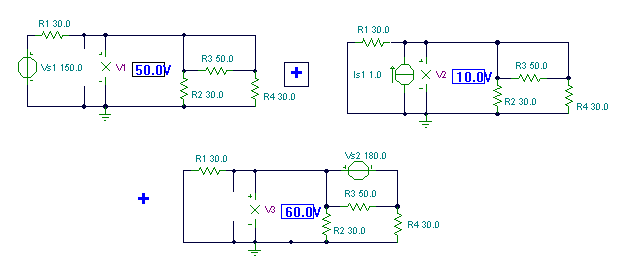

{Solution by TINA's Interpreter}
{Using superposition theorem}
V1:=Vs1*R2*R4/(R2+R4)/(R1+R2*R4/(R2+R4));
V1=[50]
V2:=Is1*R2*R4*R1/(R2+R4)/(R1+R2*R4/(R2+R4));
V2=[10]
V3:=Vs2*R1*R2/(R1+R2)/(R4+R1*R2/(R1+R2));
V3=[60]
V:=V1+V2+V3;
V=[120]
{Using superposition theorem}
V1:=Vs1*R2*R4/(R2+R4)/(R1+R2*R4/(R2+R4));
V1=[50]
V2:=Is1*R2*R4*R1/(R2+R4)/(R1+R2*R4/(R2+R4));
V2=[10]
V3:=Vs2*R1*R2/(R1+R2)/(R4+R1*R2/(R1+R2));
V3=[60]
V:=V1+V2+V3;
V=[120]
You can see that using the superposition theorem for circuits containing more then two sources is pretty complicated. The more sources there are in the circuit, the more steps are required. This is not necessarily the case with the other, more advanced methods described in later chapters. If superposition requires you to analyze a circuit three or more times, it is all too easy to mix up a sign or make some other mistake. So if the circuit has more than two sources--unless it is very simple--it is better to use Kirchhoff’s equations and its simplified versions, the methods of nodal voltages or mesh currents described later.
While the superposition theorem can be useful for solving simple practical problems, its main use is in the theory of circuit analysis, where it is employed in proving other theorems.
http://hyperphysics.phy-astr.gsu.edu/hbase/electric/suppos.html
Superposition: Two Loop Problem
To apply the superposition theorem to calculate the current through resistor R1 in thetwo loop circuit shown, the individual current supplied by each battery is calculated with the other battery replaced by a short circuit.

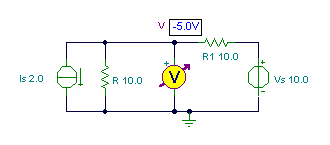
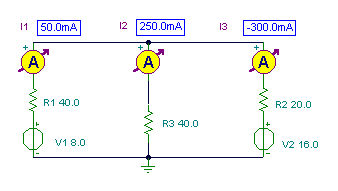

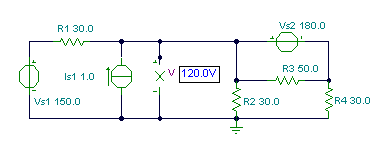
No comments:
Post a Comment